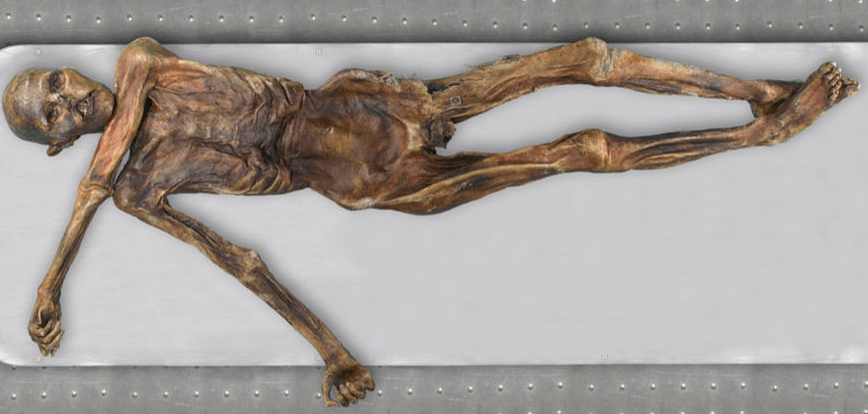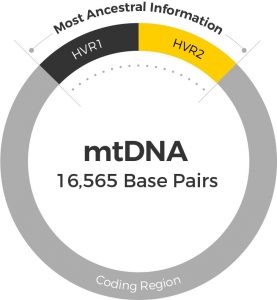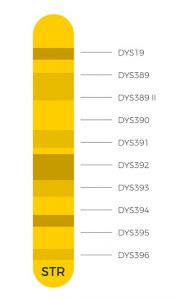Profiles in this project
This project has 1 profile for comparison.

mtDNA and Y-DNA profiles are known for Ötzi. Find out if you may have family links to Otzi, Europe’s oldest iceman found to date.
Two people are hiking along a glacier when they come across a brown, leathery shape stuck in ice. When a closer examination makes them realize it’s a human body, one hiker passes out. In a matter of few hours, the area secured with crime scene tape is swarming with cops and crime scene investigators. Remind you of an episode from the TV show Bones? Well, it’s not.
This is the true story of the discovery of Ötzi the Iceman (except for the part where one of the hikers passes out), and what genetic analyses reveal to us about this ancient European. Given the mystery behind exactly how Ötzi ended up frozen, it most certainly would make a perfect backstory for an episode of Bones.
Ötzi’s story began in 1991 when two hikers discovered his body at a rock-gully in a glacier near the Austro-Italian border. The Austrian police soon realized they were not dealing with an ordinary mountaineering accident, but an ancient archaeological site. They brought in a scientific team to carefully extract the remains, which were then taken to the Institute of Forensic Medicine in Innsbruck.
Since he was such an incredibly valuable archaeological find, both Austria and Italy staked their claims for Ötzi. After a border survey, Italy gained legal possession of his body and artefacts. They now rest in a climate-controlled facility at the South Tyrol Museum of Archaeology in Bolzano, Italy.

Radiocarbon dating of the Tyrolean Iceman or Ötzi the Iceman (named after the region of Alps his remains were discovered) showed that he was over 5000 years old. He lived between 3350 and 3100 BC – which corresponds to the Late Neolithic Era or the Copper age.
This meant Ötzi was Europe’s oldest known natural mummy. He was even older than the Egyptian and Inca mummies that have been found to date.

Ötzi was also rather unique from the Egyptian mummies whose bodies were preserved using intentional dehydration. He was what you call a 'wet' mummy, because the spontaneous freeze-drying process has captured the humidity and kept his body, clothing and equipment in an incredible state of preservation.
Ötzi’s body was perfectly intact, untouched by funeral rituals like embalming. The entire body remained nearly as it was on the day he had died, including what was stored in his digestive tract.
Over the years scientists have learned quite a bit about Ötzi. He was approximately 46 years old, and suffered from tooth decay, gum disease and worn joints. This is understandable because Ötzi would have been considered elderly in the Copper Age.

He also sported tattoos. However, these may have been therapeutic, rather than symbolic. The markings were made by rubbing charcoal over small cuts, not with a needle and ink, as has been seen with other cultures. The locations of his tattoos were amazingly consistent with known acupuncture points that were discovered by the Chinese 2000 years after Ötzi’s existence.
Using the contents from his stomach, scientists even pieced together that Ötzi had climbed all the way from the valley floor to the top of the pass just 24 hours before he died.
And perhaps the most intriguing fact about Ötzi was that he didn’t die from exposure. He was murdered with an arrow to the back and a mace blow to the face.
DNA tests were performed on samples from Ötzi to learn more about where Ötzi had come from, and how modern Europeans are related to this ancient human. As DNA sequencing technologies evolved scientists were able to gradually piece together a picture of where Ötzi came from and what life would have been like in the Copper Age. The following summary of his genetic history is the work of many scientists that spanned over more than a decade.
The first genetic investigation performed in 1994 focused on the mitochondrial genome.
Mitochondria are the powerhouses in our cells. Mitochondrial DNA (mtDNA) is ideal for analysing ancient human remains, because there are hundreds of mitochondria in each of our cells. They evolve rapidly and are strictly maternally inherited (passed from mother-to-child).

There are three regions of the mtDNA genome: the coding region (which contain the instructions for genes) and two non-coding regions called HVR1 and HVR2. Only the HVR1 region was sequenced from soft tissue and bone samples collected from Ötzi in 1994.
In 2000, the mummy was defrosted for the first time. Samples were collected from his intestine to use for animal- and plant-DNA analysis. This showed that Ötzi’s last two meals were chamois and red deer, along with bread, roots and fruits.
Further mtDNA analyses were conducted in 2000. But, the entire mtDNA sequence was not obtained until 2008, when sequencing technologies finally caught up.
mtDNA analysis allows us to trace maternal ancestry, and see where we fit in the global mitochondrial family tree.
At the root of this tree is “Mitochondrial Eve.” The major branches are called mtDNA haplogroups (you can think of these as ancient family groups). These major branches are further divided into what are known as subclades (think of these as smaller family groups – different families that share the same last name for example).
Ötzi belonged to the mtDNA subclade K1. But interestingly, his mtDNA sequence was different from all existing branches within the K1 subclade (K1a, K1b and K1c). So, he was given a new subclade of his own, K1f.

In 2012, researchers sequenced the entire nuclear genome of Ötzi, including the paternally inherited Y chromosome. Y-DNA is passed down from father to son (strictly paternally inherited) and is useful for tracing paternal ancestry. And like with the mtDNA tree, it can tell us where we fit in the Y-DNA family tree.
Y-DNA analysis found that Ötzi belonged the Y-chromosome haplogroup G in the subclade G2a2b (previously called G2a4). This subclade is now mostly found in South Corsica.
Looking at the DNA from rest of Ötzi’s genome (autosomal DNA) further confirmed a close relationship to southern Europeans, especially in the geographically isolated populations of Corsica and Sardinia.
Scientists also uncovered several other interesting characteristics of Ötzi using his autosomal DNA. He had brown eyes, belonged to blood group O, was lactose intolerant and had an increased risk of coronary heart disease. They also found DNA from the bacteria Borrelia burgdorferi suggesting that Ötzi may have had Lyme disease, the earliest human known to suffer from it.

His maternal line has been lost from present-day populations. But his paternal line is still observed in Europe, particularly in Corsica and Sardinia. Scientists think the explanation may be geographical isolation.
The idea is that following a population expansion and migration through Europe, Sardinians and Corsicans were isolated in the Alps. In their isolation they maintained the K1f branch, while it was replaced by other more common haplogroups in the rest of the continent.
It’s possible that the genetic profile of Ötzi was once widespread throughout Europe, before it became restricted to just the isolated populations in the Tyrrhenian Sea.
Decades of hard work has gone into uncovering what we know about Ötzi today. As technologies advance, we are sure to find out even more about him. Together these studies have generated the complete genome sequence of Ötzi, the first complete genome sequence of a prehistoric European.
If you have taken the DNA Maternal Ancestry Test and/or the DNA Paternal Ancestry Test, you can now find out whether you are related to Ötzi the Iceman, as well as where you fit in the mtDNA and Y-DNA phylogenetic trees.
Handt O et al. (1994) Molecular genetic analyses of the Tyrolean Ice Man. Science. 264(5166):1775-8.